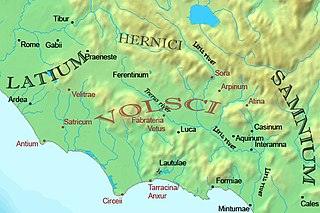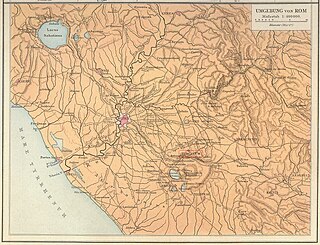The Hernici were an Italic tribe of ancient Italy, whose territory was in Latium between the Fucine Lake and the Sacco River (Trerus), bounded by the Volsci on the south, and by the Aequi and the Marsi on the north.
The Hernici were an Italic tribe of ancient Italy, whose territory was in Latium between the Fucine Lake and the Sacco River (Trerus), bounded by the Volsci on the south, and by the Aequi and the Marsi on the north.

For many years of the early Roman Republic, the Hernici were allied with Rome and fought alongside it against its neighbours.[ citation needed ]
In 495 BC Livy records that they entered into a treaty with the Volsci against ancient Rome. [1] [2]
They long maintained their independence, and in 486 BC they were still strong enough to conclude an equal treaty with the Latins. [3] [4] [5]
In 475 BC they fought alongside the Latins against the Aequi and Volsci, and in the same year fought alongside Rome against the Veientes and Sabines. [6] In 468 BC they fought alongside Rome against the Volsci. [7]
In 464 BC they warned Rome of the betrayal of Ecetra, and fought alongside Rome against the Aequi who were allied with the Ecetrans. [8]
They broke away from Rome in 362 [9] and in 306, [10] when their chief town Anagnia was taken and reduced to a praefectura, but Ferentinum, Aletrium and Verulae were rewarded for their fidelity by being allowed to remain free municipia , a position which at that date they preferred to the civitas. [11]
The name of the Hernici, like that of the Volsci, is missing from the list of Italian peoples whom Polybius [12] describes as able to furnish troops in 225 BC. By that date, therefore, their territory cannot have been distinguished from Latium generally, and it seems probable that they had then received the full Roman citizenship. The oldest Latin inscriptions of the district (from Ferentinum [13] ) are earlier than the Social War, and present no local characteristic. [11]
| Hernican | |
|---|---|
| Region | Italy |
| Extinct | yes |
Indo-European
| |
| Old Italic alphabet | |
| Language codes | |
| ISO 639-3 | xhr |
xhr | |
| Glottolog | hemi1234 |
A couple of inscriptions show that the Hernican language was a member of the group of Osco-Umbrian (Sabellian) languages. Their name, with its "co" termination, classes them along with the "co"-tribes, like the Volsci, who would seem to have been earlier inhabitants of the west coast of Italy, rather than with the tribes whose names were formed with the "no"-suffix. [11]

The Volsci were an Italic tribe, well known in the history of the first century of the Roman Republic. At the time they inhabited the partly hilly, partly marshy district of the south of Latium, bounded by the Aurunci and Samnites on the south, the Hernici on the east, and stretching roughly from Norba and Cora in the north to Antium in the south. Rivals of Rome for several hundred years, their territories were taken over by and assimilated into the growing republic by 304 BC. Rome's first emperor Augustus was of Volscian descent.

Spurius Cassius Vecellinus or Vicellinus was one of the most distinguished men of the early Roman Republic. He was three times consul, and celebrated two triumphs. He was the first magister equitum, and the author of the first agrarian law. The year following his last consulship, he was accused of aiming at regal power, and was put to death by the patricians.

The Battle of Lake Regillus was a legendary Roman victory over the Latin League shortly after the establishment of the Roman Republic and as part of a wider Latin War. The Latins were led by an elderly Lucius Tarquinius Superbus, the seventh and last King of Rome, who had been expelled in 509 BC, and his son-in-law, Octavius Mamilius, the dictator of Tusculum. The battle marked the final attempt of the Tarquins to reclaim their throne. According to legend, Castor and Pollux fought on the side of the Romans.
Agrarian laws were laws among the Romans regulating the division of the public lands, or ager publicus. In its broader definition, it can also refer to the agricultural laws relating to peasants and husbandmen, or to the general farming class of people of any society.

The Battle of Mount Algidus was fought in 458 BC, between the Roman Republic and the Aequi, near Mount Algidus in Latium. The Roman dictator Lucius Quinctius Cincinnatus turned an expected Roman defeat into an important victory.
Appius Claudius Sabinus Regillensis or Inregillensis was the legendary founder of the Roman gens Claudia, and consul in 495 BC. He was the leading figure of the aristocratic party in the early Roman Republic.
The Albans were Latins from the ancient city of Alba Longa, southeast of Rome. Some of Rome's prominent patrician families such as the Julii, Servilii, Quinctii, Geganii, Curiatii and Cloelii were of Alban descent.

The gens Cloelia, originally Cluilia, and occasionally written Clouilia or Cloulia, was a patrician family at ancient Rome. The gens was prominent throughout the period of the Republic. The first of the Cloelii to hold the consulship was Quintus Cloelius Siculus, in 498 BC.
Lucius Aebutius Helva was a politician and general of the Roman Republic. He was consul in 463 BC with Publius Servilius Priscus, but died of the plague during his term.
Caeso Fabius Vibulanus was consul of the Roman Republic in 484, 481, and 479 BC. He had earlier held the office of quaestor parricidii in 485 BC in connection with the trial and execution of Spurius Cassius Vecellinus.
The Roman–Latin wars were a series of wars fought between ancient Rome and the Latins, from the earliest stages of the history of Rome until the final subjugation of the Latins to Rome in the aftermath of the Latin War.

The Roman–Hernici conflicts occurred intermittently in the 5th and 4th century BCE. Both were Italic peoples settled in Latium, with the Romans speaking Latin and the Hernici an Osco-Umbrian language.
Titus Sicinius (Sabinus?) or Siccius was a Roman Republican politician during the beginning of the 5th century BC. He served as Consul of Rome in 487 BC, serving together with Gaius Aquillius Tuscus.
Titus Quinctius Capitolinus Barbatus was a Roman statesman and general who served as consul six times. Titus Quinctius was a member of the gens Quinctia, one of the oldest patrician families in Rome.
The Roman–Sabine wars were a series of wars during the early expansion of ancient Rome in central Italy against their northern neighbours, the Sabines. It is commonly accepted that the events pre-dating the Roman Republic in 509 BC are semi-legendary in nature.
The Roman-Aequian wars were a series of wars during the early expansion of ancient Rome in central Italy fought against the Aequi, an Italic tribe located to their east.
Quintus Fabius Vibulanus was an aristocrat of the Early Roman Republic. He was the first of three brothers to hold the consulate, in both 485 and 482 BC.
Servius Sulpicius Camerinus Cornutus was a Roman politician in the 5th century BC, consul in 461 BC and decemvir in 451 BC.
Titus Veturius Geminus Cicurinus was a Roman politician of the 5th century BC, consul in 462 BC and maybe decemvir in 451 BC.
Lucius Lucretius Tricipitinus was a Roman senator in the fifth century BC, and was consul with Titus Veturius Geminus Cicurinus in 462 BC.